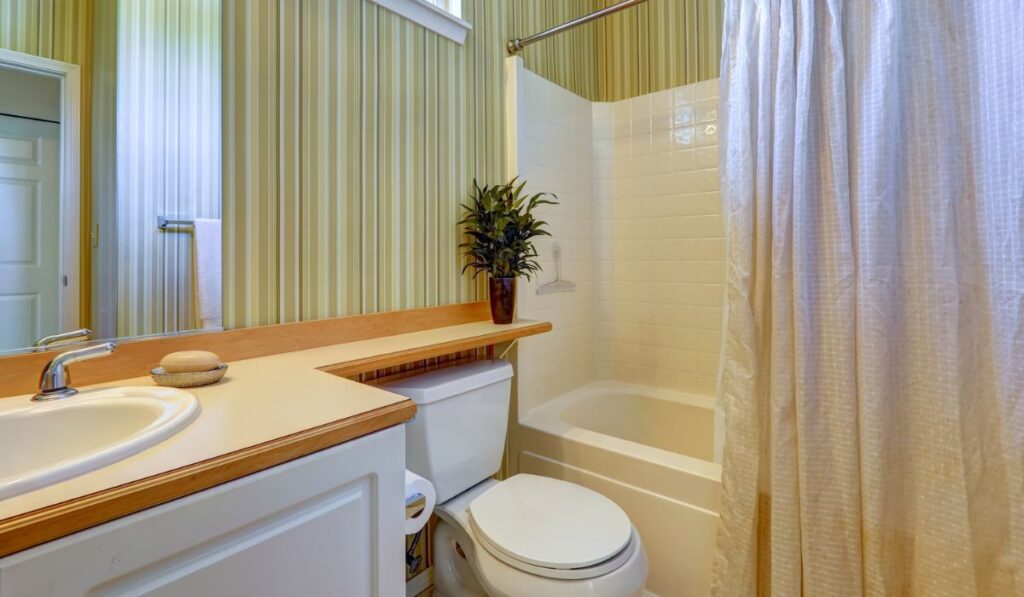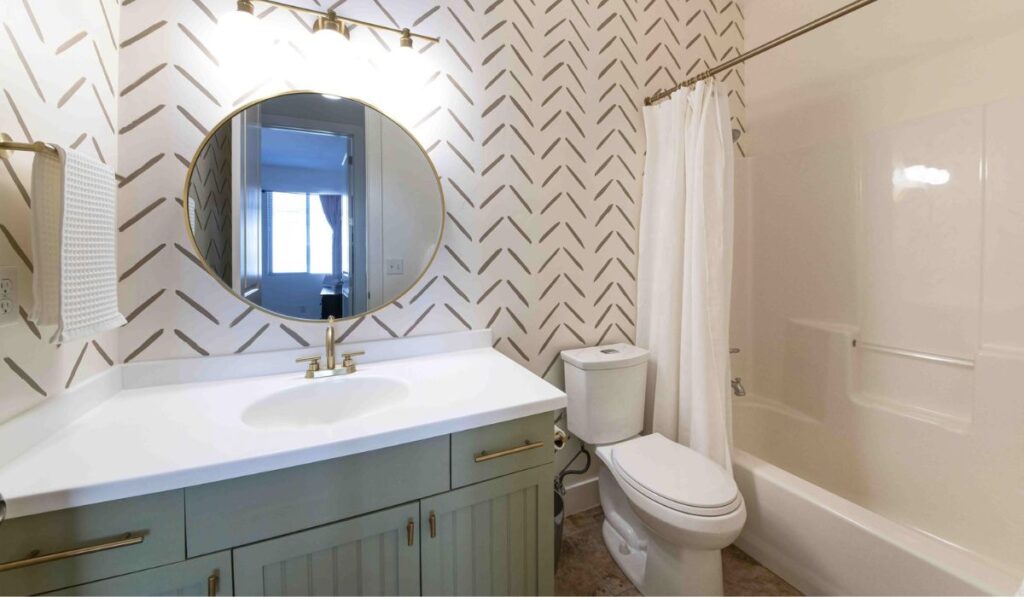Due to the emphasis on its functionality, your bathroom can be one of the most challenging spaces to design. While choosing the right bathroom paint helps, a good wallpaper can add a touch of elegance and flair you can’t rival with glossy paint and tiles.
The wallpaper you choose for your bathroom should be a waterproof and water-resistant type. Moisture-resistant wallpapers made from PVC, fiberglass, and vinyl are safe to use as they won’t attract mildew or fall off. Also, the wallpaper will hold out well if your bathroom has proper ventilation.
While you can go bold with color and pattern to create a stellar ambiance, ensure the wallpaper you choose blends well with your bathroom decor and vanities. A bathroom wallpapered in a conflicting style is so flashy and unforgivable. So let’s dive in so you figure out how to do this right and tackle humidity concerns.
Can You Use Wallpaper in The Bathroom?

You can use waterproof wallpaper in any of your bathrooms, whether you prefer it in the primary bathroom, guest bathroom, or powder room. A quality peel-and-stick wallpaper uses sophisticated adhesives to create a special membrane that protects it from direct contact with water.
Other modern waterproof wallpapers also use a thick vinyl coating to keep away moisture. So whichever style of these wallpapers you choose, you can always rest assured they’ll stand up to the daily rigors of your bathroom.
While you may be tempted to buy a standard peel-and-stick wallpaper, it won’t hold out against the humidity you expect in an average bathroom.
Tips for Putting Wallpaper in Your Bathroom
If you’ve decided to put wallpaper in your bathroom, you should consider certain factors to simplify the task and ensure the wallpaper serves you long enough. Here are the crucial tips to follow when putting wallpaper in your bathroom:
- Restrict wallpapers to areas that won’t have a lot of water splashes.
- Check the installation instructions to know the type of wallpaper and adhesive you’re using and how to remove the wallpaper.
- Prepare the wall adequately by cleaning it to remove grease and soap residue. Let it dry well before sticking your wallpaper.
- Only apply wallpaper once you’ve confirmed your bathroom is well-ventilated so it won’t be affected by humidity. If your bathroom window is small, install an efficient extractor fan to remove moisture that could damage the wallpaper quickly.
- To make your wallpaper last longer, add a clear coat of decorator’s varnish to add an extra layer of protection from moisture.
- Do not install grasscloth wallpaper in your bathroom. It easily attracts stains and is pretty challenging to clean.
Can You Wallpaper Shower Walls?
You can wallpaper shower walls, but ensure you stick with moisture-resistant wallpapers. Many of these are made from materials like PVC, vinyl, or fiberglass. Unfortunately, traditional wallpapers aren’t moisture-resistant enough to withstand the high humidity in your shower stall.
You can find waterproof wallpaper in a wide range of colors and patterns, allowing you to customize your bathroom’s look and mood easily.
They won’t allow water to penetrate easily, and you can quickly wipe them dry after exposure to moisture. Instead, choose a highly wash-resistant wallpaper that covers your shower walls entirely.
Installing Wallpaper in Your Shower
If you decide to work with vinyl wallpaper, ensure it’s solid vinyl wallpaper. Traditional wallpaper with a top coat of vinyl may work in your bathroom, but it’s not fit for the shower stall.
Before installing wallpaper in your shower, you must prepare the walls adequately.
- Use spackle to fill any noticeably large gaps and holes, clean the walls thoroughly and let them dry. Remember, any moisture trapped beneath the wallpaper will attract unsightly mold and mildew.
- Once the walls are sparkling clean, apply a mold-resistant primer across the entire area. Wear safety goggles, a respirator, and gloves when working with primers. Moreover, ensure the shower is well-ventilated.
- Next, carefully install your shower wallpaper, pressing it gently with a roller if possible to ensure it’s flush with the wall. Experts recommend you apply extra paste around the edges of the working area to ensure the wallpaper sticks well for longer. And if it’s not self-sticking wallpaper, use a mold-resistant paste to bond it.
Is Wallpaper Okay for Bathrooms?
It’s okay and safe to use wallpaper in your bathroom, provided it won’t hold moisture and attract mildew or quickly peel off after installation.
Ventilation
Most people worry that bathroom wallpaper will build up enough condensation and fall off or attract mold. But for your wallpaper to fall off your bathroom walls or encourage rapid mold growth, there must be lingering humidity.
When you first get out of the shower, your bathroom may be steamy and humid, but the excess moisture usually stays there only for a short while.
Your exhaust fan does a remarkable job getting rid of the moisture and ventilating the space properly. This significantly reduces the chances of mold or mildew growing and messing with the wallpaper.
Water-Resistance
Moreover, manufacturers create modern wallpapers with better properties like increased water resistance. They’re also easy to clean, and you can wipe them with a soft, moist cloth without inflicting damage.
While these wallpapers boast remarkable properties that make them fit for the bathroom, you must take proper care of them. Always keep your bathroom adequately ventilated for the walls to dry well. Clean it regularly and allow the moisture to escape, so your wallpaper always looks as clean and fresh as possible.
And unless you don’t mind taking a toll on the longevity of your wallpaper, you don’t want a steamy shower right after you’ve installed the wallpaper.
What Type of Wallpaper is Best for a Bathroom?

The best wallpaper for your bathroom is a bold, patterned wallpaper that bounces light softly around the room. It should also distract corners, blending with the rest of the space rather than appearing shadowy and making the room feel smaller.
Besides the appearance, you should consider the durability of the wallpaper. Vinyl wallpaper is the most affordable and durable. You can use it in areas prone to splatter and splashes, like around the shower or behind the toilet. You can also use one to surround a vanity with a vessel sink instead of a recessed sink.
While you could embellish the primary bathroom with a fragile wallpaper, it would be a disaster in the kids’ bathroom. But even in the full bath, you should hang the wallpaper on walls opposite your shower, tub, or toilet. If you’re using textured wallpaper, seal it with varnish.
The pattern or style of your wallpaper is one thing. But can it hold to the climate of your bathroom? If you have kids who are notorious for flooding the bathroom too often, opt for less traditional wallpapers.
In that case, the wallpaper border should be below the ceiling, around a mirror, window, or door. This is better than wallpapering the whole bathroom.
